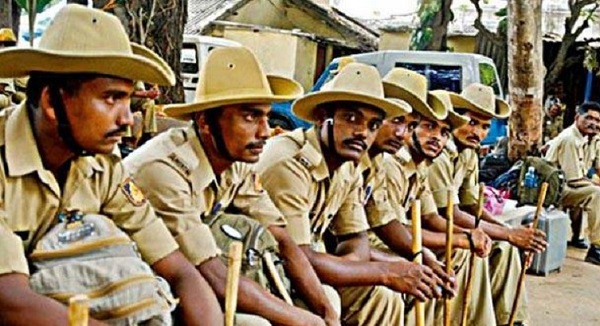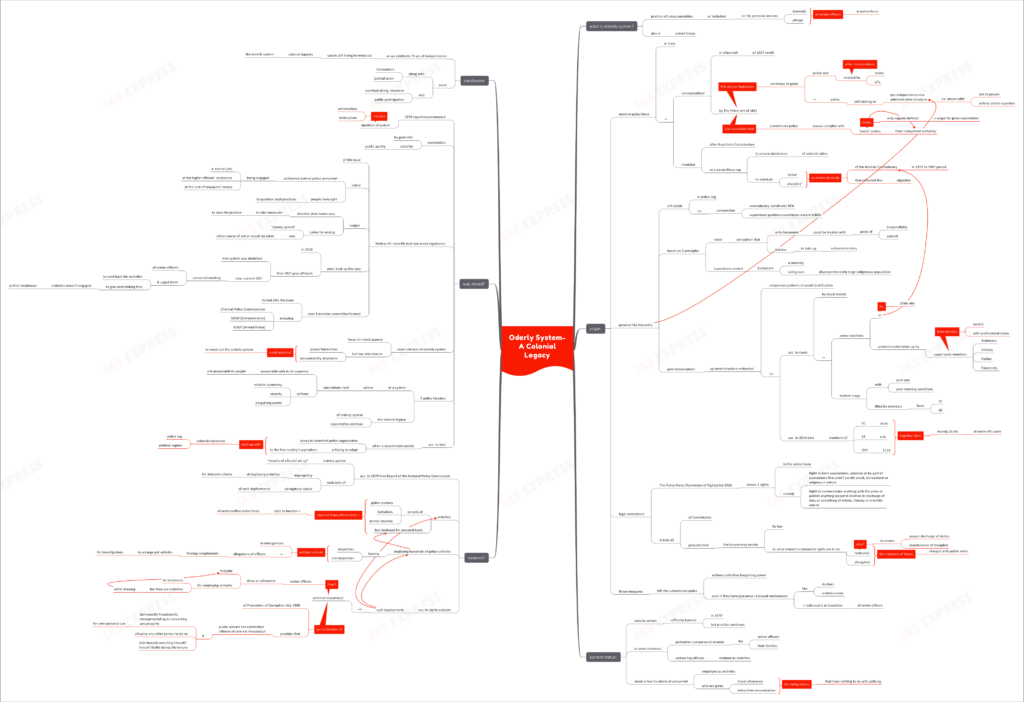Orderly System- A Colonial Legacy

From Current Affairs Notes for UPSC » Editorials & In-depths » This topic
IAS EXPRESS Vs UPSC Prelims 2024: 85+ questions reflected
What is the orderly system?
- The orderly system is the practice of using constables as ‘orderlies’, for the official and domestic personal service of the senior officers in the police force.
- This system isn’t unique to the police system. It also exists in the armed forces.

How did it originate in India?
- The modern police force in India was conceptualized by The Police Act of 1861– in the aftermath of the 1857 Mutiny. It was modelled on the Royal Irish Constabulary and designed as a paramilitary organization to secure the colonial rulers’ dominance.
- This archaic legislation continues to guide the police acts enacted by the states and UTs, even after independence. As a result, the police, still adhering to the pre-independence era administrative structure, is answerable- not to the people it governs- but only to its administrative superior.
- The 1861 Act mandates the subordinate police to comply with any ‘lawful’ order from a ‘competent authority’– terms that are only vaguely defined in the pre-independence era legislation. This has created scope for gross exploitation.
- This administrative setup was designed to maintain ‘order’ and ‘discipline’ within the force. A study of the Madras Constabulary in the 1859 to 1947 period noted how the recruitment pattern reflected this objective.
- The pyramid-like hierarchy is still visible in the police organization- constabulary constitutes 86% of the total force, while the supervisory positions (i.e. the IPS cadre) constitutes a mere 0.86%.
- This pyramid structure was formed based on 2 principles:
- Racial– i.e. the perception that only the Europeans could be trusted with posts of responsibility and command, and Indians were to take up subservient roles.
- Supervisory control– i.e. Europeans were a minority and had to rule over a disproportionately large indigenous population.
- When the police force was Indianized, this pyramid structure began to increasingly embody the indigenous patterns of social stratification.
- For instance, a study by David Arnold noted that the senior positions in the Madras Police, by the 1930s-40s, was predominantly taken up by the upper castes like Brahmans, Naidus, Vellalas and Nayars. These officers were mostly from landed families or families with professional status.
- At the same time, the bottom rungs, with poor pay and work conditions, were mainly filled by members of the Scheduled and Backward Classes.
- Notably, data from 2014 shows that members of SC (10.4%), ST (4.9%) and OBCs (11.1%) together form merely 26.4% of the entire IPS cadre.
- This is added to by The Police Force (Restriction of Rights) Act, 1966 denying 2 rights to the police force:
- Right to form associations, unionize or be part of associations that aren’t purely social, recreational or religious in nature.
- Right to communicate anything with the press or publish anything except in relation to discharge of duty or something of artistic, literary or scientific nature.
- Article 33 of the Constitution provides that the Parliament may decide, by law, to what extent any of the fundamental rights are restricted/ abrogated for members of forces charged with public order. This was done to ensure “proper discharge of their duties and the maintenance of discipline among them.”
- These measures left the subordinate police without any collective bargaining power. While these laws applies to the entire police force, the existence of hierarchies have made it disproportionately detrimental for the subordinate police.
- While there are avenues of grievance redressal– such as durbars and orderly rooms- the redressal is often at the senior officers’ discretion.
What is its current status in India?
- Officially, the orderly system was banned in 1979. However, it is still common to see policemen running personal errands for the senior officers and their family members.
- In some instances, retired top officers are retained as orderlies for this purpose.
- Estimates put the number of police personnel deployed at the residences of senior officers at a few hundreds.
- These orderlies are given travel allowances and remuneration for extra time for performing chores that have nothing to do with policing.
Why is this concerning?
- The 1979 First Report of the National Police Commission observed that the orderly system “smacks of a feudal set up”. The report also took note of the impropriety of deploying orderlies for domestic chores and the derogatory nature of such deployments.
- Technically, the orderlies are on the rolls of police stations, battalion or armed reserve strength. When they are deployed for such personal tasks, the resulting absence from official duty adds to the burdens of an already understaffed police force.
- The use of the hundreds of police vehicles for personal use leaves Inspectors and Sub-Inspectors without vehicles during emergencies. There have been allegations of officers forcing complainants to arrange private vehicles for carrying out investigations.
- Rights activists have argued that such deployment of police personnel and vehicles for personal use would count as criminal misconduct. This is because the officers already draw a ₹10,000 allowance for engaging servants at their residences. Yet, they don’t employ servants and instead use the orderlies to perform the task.
- Section 13 of the Prevention of Corruption Act, 1988, holds that a public servant is said to have committed an offence of criminal misconduct upon
- Dishonestly/ fraudulently misappropriating or converting, for own personal use, any property (entrusted to him/ her or placed under his/ her control as a public servant) or
- Allowing any other person to do so or
- Intentionally enriching himself/ herself illicitly during the tenure.
What is the way ahead?
- The 1979 report recommended that the orderly system be abolished, as mere exhortations and instructions won’t cut it.
- This exploitation by the government elite is also being aided by the public apathy towards the subordinate police’s plight.
- The Madras High Court recently took suo motu cognizance of the problem. It noted how uniformed trained police personnel are being engaged in menial jobs at the higher officials’ residences, at the cost of taxpayers’ money. The court asserted that the public’s right to question such practices.
- The Judges directed the State Home Secretary to take measures to stop the engagement of uniformed personnel as orderlies. It called for the abolition of this ‘slavery system’, failing which the court will resort to other course of action.
- When the High Court had previously taken up the issue in 2018, the then Director General of Police had given an affidavit that the system had been abolished. More recently, the incumbent DGP convened an urgent meeting with the senior police officers and urged them to send back those personnel engaged as orderlies in the camp offices and residences. He asked the senior officers (above the rank of SP) to give an undertaking that there weren’t any orderlies engaged in their residences.
- A 3-member committee, consisting of the Chennai Police Commissioner, ADGP (Administration) and ADGP (Armed Police), was constituted to look into the issue and take suitable action.
- While most criticism of the orderly system focus on the moral aspects of the issue, little attention is being paid to the power hierarchies and accountability structures within the police force. These aspects also need an overhaul if the orderly system is to be weeded out.
- If the police functions in a system where the subordinate rank is answerable only to their superiors, and not the people, and functions without relative autonomy, security or bargaining power, the colonial legacy of orderly system is expected to continue.
- According to Upendra Baxi, when a decolonized society keeps its inherited police organization, refusing to adapt to the free society’s aspirations, it ends up with a colonial-repressive police organization and political regime.
Conclusion:
As India celebrates its 75th year of independence, the courts are still trying to get rid of colonial legacies like the orderly system. Mere instructions and judicial orders won’t help without an overhaul of the organizational structure and public participation.
Practice Question for Mains:
What is the orderly system plaguing the police force in India? Why does the practice persist despite its abolition? (250 words)
If you like this post, please share your feedback in the comments section below so that we will upload more posts like this.

